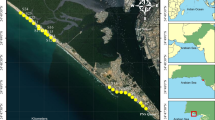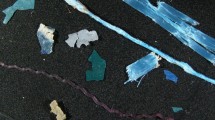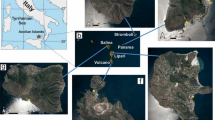Abstract
Plastics are primary marine pollutants that significantly threaten the environment, contaminating every part of the globe. As a result, litter is abandoned alongside the Algeria coastline. The most common litter includes plastic fragments, fishing gear, and packaging. About 90% of recorded items are plastic. The impacts of this pollution are still unknown, especially from microplastic levels. In this study, macro- and microplastics were sampled on several beaches on the Algerian coast to estimate their concentration. The orientation, degree of use, and slope of each beach and the distance from the large urban area were all measured to state their contribution to the accumulation of marine litter. Plastic litter along the coast was studied using a monitoring approach for identifying, collecting, and quantifying plastic debris. We used attenuated total reflection Fourier transformed (ATR-FTIR) spectroscopy to identify our samples. Two thousand two hundred and thirty-seven plastic particles were collected from different sampling points on the five beaches studied. Our samples contain 698 pieces >5 mm, 920 pieces are 4–5 mm, 532 pieces are 3–4 mm, 68 pieces are 2–3 mm, and 19 pieces are 1–2 mm were the most abandoned types of polymer. Polyethylene (PE), polypropylene (PP), polystyrene (PS), polyethylene terephthalate (PET), PVC, and NYLON accounted for 67%, 21%, 5%, 4%, and 3%, respectively.
Access provided by Autonomous University of Puebla. Download conference paper PDF
Similar content being viewed by others
Keywords
1 Introduction
Plastic pollution is one of the world’s most pressing environmental issues. However, over the past decade, approximately 12 metric tons have been leaking into our oceans annually, and there has been significant attention to macro-litter (Microplastic Pollution: The Policy Context - Background Paper). As a result, scientists believe microplastics (plastics < 5 mm) are a considerable concern and consider them hazardous substances. Of the nearly 300 recognized impacts on wildlife from marine litter, over 70% can be attributed to microplastics (Plastic Strategy, 2018). They are especially dangerous as they can move through the food chain, creating compounded effects of their dangers (Plastic Strategy, 2018). Yet, little is known about microplastic levels or their impacts in Algeria.
Algeria is a transforming country and not a producer of plastic. The recovery activity represents only 7% of the plastic consumed. In 2019, Algeria became the world’s fifth largest consumer of plastic bags after the United States of America, Morocco, France, and Italy, with 6.5 to 7 billion plastic bags per year (Pollution in the Middle East & North Africa; The plastic in the Mediterranean Sea, 2018). The estimation of plastic litter per year is 17332 tons, and due to a failing recycling industry, 60–80% of waste is dumped into the marine environment (The plastic in the Mediterranean Sea, 2018).
Microplastic pollution is considered an emergency crisis. Therefore, the main objective of this study is to conduct primary research on microplastics on several beaches and validate the hypothesis that there is a positive correlation between microplastic concentrations and particle size along the beach profile.
2 Materials and Methods
Several field trips were made during January, March, April, June, and July 2019 to carry out sampling campaigns on the beach sediments using the Transect-Quadrat method (www.arocha.org/wp-content/uploads/2018/01/Microplasticsbibliography.pdf). This method consists of a uniform distribution of 10 lines perpendicular to the shore (transect), separated by a minimum of 10 m (Fig. 1).
2.1 Study Area
Five different areas were selected from the Algerian coastline as follows:
-
1.
Beach with intense fishing activity
-
2.
Beach with low fishing pressure
-
3.
Beach with touristic activity
-
4.
Beach near a disposal site
-
5.
High biodiversity beach.
We had chosen one day before and one day after a storm and then used a quadrat of 50/50 cm for field trips. We collected the upper 2 cm surface layer and used sieves, which retain all that is <5 mm microplastic. The samples were kept at −4 °C. We used a binocular magnifier and NaCl for density separation for the quantification. Finally, FT-IR spectroscopy is used to identify the polymer type (Fig. 2).
3 Results
3.1 Analyzing Microplastic from Sediment
Using the data collected from the 25 samples of coastal sediments, the preliminary results state that all microplastics identified were from a “secondary” origin.
Fragments and fibers constitute most of the samples (71–81%), preceded by films (5–23%) (Fig. 3).
We enumerated 2237 pieces of plastic from various sampling points on the surveyed beaches: 698 pieces >5 mm, 920 pieces 4–5 mm, 532 pieces 3–4 mm, 68 pieces 2–3 mm, and 19 pieces 1–2 mm.
3.2 Microplastics Identification
-
We used the FT-IR spectrometer to identify and document the chemical classification of plastics we found.
-
The microplastic samples are placed under the FT-IR instrument, which uses infrared radiation to determine the types of polymer present in the samples.
-
The most abandoned types of polymers detected were polyethylene (PE), polypropylene (PP), polystyrene (PS), polyethylene terephthalate (PET), PVC, and NYLON accounting for 67%, 21%, 5%, 4%, and 3%, respectively.
-
The identification of polymer types was determined by comparing resulting spectra samples with a reference database, which helped us select the origin of our samples and identify the potential sources of these microplastics. This research study collaborates with oceanographers who study the currents so we can identify where the plastics may have come from.
4 Discussion
The preliminary results of our study show that microplastics are pervasive in beach sediments along the Algerian coast. The primary sources of plastic debris found on Algiers coastal beaches were land-based activities (such as commercial practices, agricultural and manufacturing practices, and tourist' litter and waste disposal). On the other hand, we also have sea-based fishing activities. Fragments were the most common shape type of microplastics (in terms of number), followed by Pellets and Fibers. PE, PP, PVC, and PS are recognized as fragments. PE or PP is used to manufacture pellets. PE, PP, and Nylon are confirmed as fibers. FT-IR spectroscopy analysis indicated that most plastics were polyolefins, which are plastic resins with a specific gravity of less than one, permitting them to be positively buoyant and quickly deposited on beaches (Andrady, 2011). This is not surprising because PE, with a global annual production of about 80 million tonnes, is predominantly used in packaging (plastic films, containers including bottles, and plastic bags).
Furthermore, with a total global production of around 55 million tonnes, PP is primarily used for food packaging, in the textiles industry, rope manufacturing, and reusable containers. In the beach sediments, the plastic debris is due to continuous degradation regarding deposition and weathering. Beaches are better settings than other natural environments for the breakdown of plastic waste (Andrady, 2011). Hence, the plastic debris found on the five beaches will continue to fragment into smaller ones, making it easier for those tiny particles to disperse due to wind and tide movement, entering the food chain into the big ocean.
5 Conclusions
-
The samples taken from five beaches on the Algerian coast revealed a high microplastic content above the high tide line, located on shores that are not periodically cleaned and suffer from intense microplastic debris episodes.
-
The microplastic content of those different beaches is comparable, or even higher, to those found in previous studies all along the Mediterranean Sea. This suggests a prominent need to develop periodical monitoring programs for further studies.
-
Most microplastics obtained were fragments of PP, PE, PET, and PS (FT-IR was used for microplastic characterization) which is also in accordance with global plastic production.
-
Plastic pollution knows no border. Instead, plastics travel from one country to another with marine currents, highlighting the need for a regional and collaborative approach.
References
Andrady, A. L. (2011). Microplastics in the marine environment. Marine Pollution Bulletin, 62(8), 1596–1605. https://doi.org/10.1016/j.marpolbul.2011.05.030
Microplastic Pollution: The Policy Context - Background Paper, The scientific advice mechanism unit of the European commission, 68 p. web version.
Plastic Strategy. (2018). A European strategy for plastics in a circular economy. In Communication from the commission to the European parliament, the council, the European economic and social committee and the committee of the regions. Brussels, January 16th 2018 COM. Available online: https://www.ec.europa.eu/environment/circular-economy/pdf/plastics-strategy.pdf
Pollution in the Middle east and north Africa: Pollution in Algeria April 9th, 2019.
The plastic in the Mediterranean Sea. (2018). Report.
www.arocha.org/wp-content/uploads/2018/01/Microplasticsbibliography.pdf
Author information
Authors and Affiliations
Corresponding author
Editor information
Editors and Affiliations
Rights and permissions
Copyright information
© 2023 The Author(s), under exclusive license to Springer Nature Switzerland AG
About this paper
Cite this paper
Ghezali, Y., Hamdi, B., Safia, S., Skander, S. (2023). Quantification and Identification of Marine Litter on Five Beaches of the North-Central Algerian Coast. In: Çiner, A., et al. Recent Research on Environmental Earth Sciences, Geomorphology, Soil Science, Paleoclimate, and Karst. MedGU 2021. Advances in Science, Technology & Innovation. Springer, Cham. https://doi.org/10.1007/978-3-031-42917-0_14
Download citation
DOI: https://doi.org/10.1007/978-3-031-42917-0_14
Published:
Publisher Name: Springer, Cham
Print ISBN: 978-3-031-42916-3
Online ISBN: 978-3-031-42917-0
eBook Packages: Earth and Environmental ScienceEarth and Environmental Science (R0)







